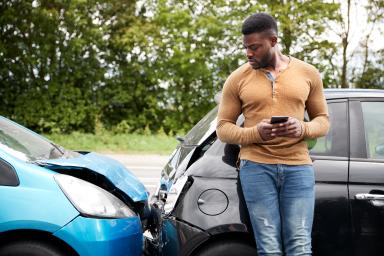Connecticut Car Accident Laws

Connecticut has seen a rising rate in fatal car accidents in the past five years, with the state’s Department of Transportation recording 324 deadly crashes and 357 fatalities by December 2022. Pedestrian and wrong-way deaths reached totals of 70 and 23, respectively, with the former coming close to the state’s record of 75 pedestrian fatalities in 1988.
According to the Connecticut Transportation Institute at the University of Connecticut, most wrong-way crashes between 2018 and 2022 involved alcohol intoxication and motorists who were driving between 11 p.m. and 4 a.m. Speeding was also a common factor in incidents between 2018 and 2020, contributing to 30.9% of the state’s fatal accidents then.
During the same period, 222 people died in accidents in New Haven County, according to National Highway Traffic Safety Administration Fatality Accident Reporting System data. Of these crashes, 13 occurred on Interstate 95, making it one of the most dangerous roads in the state.
To keep the roads safe and prevent accidents, Connecticut has enacted a number of traffic laws to assist drivers in remaining safe and responsible on the road. In the event of a crash, the state has a number of guidelines to help victims file claims and recover their losses.
Connecticut Right-of-Way Mandates
In accordance with Connecticut laws, drivers must yield the right-of-way to all approaching motorists when entering a highway from a private road or driveway, even if they are already partially on a highway. Similarly, those who are entering an intersection must grant the right-of-way to drivers to their right if they are entering the area at approximately the same time, unless directed otherwise by traffic enforcers.
In addition, all motorists are required to yield to emergency vehicles with activated lights and sirens, and they must pull over to the shoulder or as far to the right as possible to let such vehicles pass. This rule applies no matter what the traffic lights and other devices at an intersection are showing.
Drivers are also required to let pedestrians on crosswalks pass once they are given the signal to walk; if a pedestrian is still on a crosswalk by the time vehicles start moving again, motorists must wait for the pedestrian in question to reach the opposite curb or a safety zone before moving.
Drivers who fail to yield the right-of-way will be charged with traffic infractions that carry a fine of up to $500, three demerit points, and a violation record in the offender’s license and driving history, respectively. In case a violation results in a car crash or collision, the offender will be held liable in a subsequent lawsuit or injury claim.
Connecticut Seat Belt Law
Connecticut law specifies that all drivers and passengers of all ages must wear seat belts. This rule applies even for rear passengers, with an additional law being put in place by the state government, the Office of Highway Safety, and the Connecticut Department of Transportation in 2021 in an effort to curb injury and fatality rates for rear seat occupants.
The state also requires all motorists to properly secure any child passengers in cars or booster seats, with the type of seat depending on a child’s weight and age.
Children are required to ride in the back seats until they reach the age of 13. A Child Passenger Safety Technician can assist drivers who need help installing or using a certain seat for their children.
Penalties
Those who fail to adhere to seat belt guidelines must pay a fine of $92. If the violation involves the failure to use a child safety seat, the offender must pay up to $199 and attend a mandatory educational car seat class.
In instances involving unbelted rear-seat passengers, drivers cannot be pulled over solely for their failure to secure such passengers. However, they can be fined for any unbelted passengers if they were pulled over for a different moving violation.
Seat Belt Violations and Negligence
State law does not treat the failure of a driver or passenger to wear a seat belt as admissible evidence or contributory negligence in car accident cases. This means that victims can still recover damages or file a lawsuit even if they were not wearing a seat belt at the time of the accident.
Connecticut Hit-and-Run Accidents
Any driver in Connecticut who is involved in an accident is required by law to stop their vehicle at the scene of the accident and assist anyone who is injured. They must also share their name and address, as well as their license and registration numbers, with other motorists and law enforcement personnel.
Those who fail to meet these obligations will be charged with hit-and-run. As a result, they will face different penalties depending on whether it is their first or second offense or whether the accident caused any injuries, property damage, or fatalities.
The potential penalties for specific hit-and-run violations are as follows:
On repeat violations, a motorist can be fined an additional amount of $100 to $1,000, serve an additional prison sentence of one year, or both. Each violation also involves a license suspension lasting for at least 90 days and up to two years. This depends on the severity of the offense and whether it is a repeat violation.
Connecticut DUI Law
Driving under the influence of alcohol is illegal in Connecticut, and the amount of alcohol in one's blood determines the severity of the offense. Under the state's Implied Consent Law, drivers are presumed to have consented to a BAC test.
A driver is frequently deemed legally intoxicated if a test reveals a BAC level of 0.08% or higher. The threshold for those aged 21 and under is much lower; they are charged if their BAC reaches or exceeds 0.02%.
Since drunk driving is a common cause of car accidents in Connecticut, the state has different penalties for people who do it. These penalties depend on how many DUI violations a motorist has committed.
All DUI offenders must also finish a state-approved substance abuse treatment program before their license can be reinstated after it has been suspended or taken away. They may also be required to attend a victim impact panel program.
Connecticut Speed Limits
Between 2022 and 2023, speeding drivers caused 8,548 accidents, according to the Connecticut Department of Transportation. This shows how common these kinds of accidents are in the state. Because of this, laws are set in place to help drivers maintain their vehicle speed and prevent crashes from happening.
Across the state, there are varying speed limits depending on where a motorist is traveling.
In school zones, the speed limit is 15 mph.
In residential areas, the speed limit is 40 mph.
On undivided and divided roads, as well as urban interstates and freeways, the speed limit is 55 mph.
On rural freeways and interstates, the speed limit is 65 mph.
Violations of these limits result in different fines, ranging from at least $137 to $323. Extra fines are imposed if the offense occurred within a construction, traffic, school, or fire station zone. Additional penalties are also given to offenders who are under the age of 18.
If a speeding violation results in an individual’s injury or death, the offender can be fined a maximum of $1,000 or spend at least 6 months in jail. For commercial drivers, the fine increases to $2,500, and their commercial license will be suspended for up to two years.
Connecticut Minimum Auto Insurance Requirements
To help people cover the costs of injuries and damaged property in a potential car crash, Connecticut law requires all drivers to have liability insurance coverage. The minimum amounts of liability insurance required by state mandates are:
$25,000 for bodily injuries per person
$50,000 for bodily injuries per accident
$25,000 for property damage
Drivers are required to have proof of insurance at all times. Those who do not have insurance coverage are fined between $100 and $1,000. The license is suspended for one month for the first offense and up to six months for subsequent offenses. Other possible penalties include:
$50 for not carrying proof of insurance ID cards
$175 for license and registration reinstatement
$200 as a reinstatement fee for those who have canceled their insurance
Also, drivers are required by law to get coverage for uninsured and underinsured motorists (UM/UIM) in case they get into an accident with a driver who does not have enough or any liability insurance. These types of coverage are also used to cover the expenses of victims if an offending driver flees the scene of the accident.
Uninsured and underinsured motorist coverages have the same minimums as liability insurance coverage: $25,000 and $50,000 for bodily injuries per person and per accident. These can be topped off with collision and comprehensive insurance, which cover damage to the driver's own car and damage caused by things other than a collision.
Connecticut Is an “At-Fault” State for Insurance Claims
After repealing its no-fault insurance law in 1994, Connecticut became an "at-fault" insurance state, allowing those who have been injured in an accident due to another’s negligence to file claims or personal injury lawsuits to recover their losses. In these cases, the defendant's own liability insurance coverage will pay for the plaintiff's medical expenses and damaged property.
Plaintiffs can get money from the driver who caused the accident, but they can also use their collision and comprehensive insurance to fix any damage to their car. If the at-fault driver is uninsured or underinsured, or if the other driver involved fled the scene of the accident, victims can recover damages through their UM/UIM coverage, if available.
Plaintiffs can also use their collision and comprehensive insurance coverage to address any damage to their vehicle in addition to obtaining settlements from the negligent driver.
Connecticut Is a Modified Comparative Negligence State for Car Accident Lawsuits
Connecticut adheres to the basis of modified comparative negligence in car accident cases. This means that plaintiffs who are found to be partially liable for the accident in question will have their recoverable damages deducted in line with the percentage of their apportioned fault.
For example, if a car accident victim receives $100,000 in damages but is also found to be 20% liable for committing a moving violation that contributed to the crash, the court will deduct $20,000 from the award.
In addition to reducing potential settlements based on fault, modified comparative negligence laws dictate that if a plaintiff is found to be more than 51 percent at fault for an accident, no damages will be awarded. As a result, car accident victims in Connecticut must bear less than 51 percent of the blame before they are allowed to recover any losses.
A driver’s potential negligence in a car accident is assessed based on these factors:
The driver’s duty of reasonable care, which is to follow traffic regulations and maintain the safety of other motorists and pedestrians
The breach of such a duty through the violation of traffic regulations, which result in others being endangered
The causation, where the driver’s breach of duty directly caused an injury, death, or damage to a victim’s property
Connecticut Statute of Limitations for Car Accidents
According to state law, Connecticut motorists who want to file a personal injury claim or lawsuit after a car accident have up to two years to do so. The statute of limitations usually begins on the date of the accident.
If a car accident causes a victim to die from injuries later on, the statute of limitations for a wrongful death claim begins on the date of the victim's death rather than the date of the accident. However, wrongful death claims in Connecticut are barred if more than five years have passed since the date of the underlying accident that caused the victim's death.
Average Settlements for Connecticut Car Accident Lawsuits
The resulting damages in a car accident case in Connecticut vary on a case-by-case basis, meaning that there is no fixed average settlement that plaintiffs can receive. This is compounded by the fact that state laws do not impose any caps on the compensatory damages a plaintiff can receive.
In most cases, the maximum amount of insurance coverage available will determine the hypothetical limit of the damages that a plaintiff can recover in a case. For example, if the damage award is $100,000 but the available insurance coverage is only $40,000, the victim will receive only $40,000 in compensation.
Potential damages in a car accident case are often calculated based on:
Present and future medical expenses.
Repair costs for property damage.
Lost income due to a victim's incapacity to work or obtain employment because of injury/disability.
Pain and suffering resulting from reduced quality of life, loss of companionship, trauma, disfigurement, etc.
In terms of non-economic damages such as pain and suffering, a settlement can be calculated for such losses using one of two methods:
The multiplier method, where a plaintiff’s total economic damages are multiplied by a number between one to five, depending on the severity of the victim’s injury
The “per diem” method, where a certain amount of money is paid daily in accordance with the burden of a plaintiff’s pain and suffering, starting from the date of the accident to the date of the victim’s maximum recovery
Legal Resources for Connecticut Car Accident Victims
CT.gov - Filing Claims against The Department of Transportation
The official website of the state of Connecticut provides a set of instructions and reminders for individuals who wish to file an accident claim against the Connecticut Department of Transportation. This applies to those who have been injured in a crash that was caused by a defect in a roadway that falls under the DOT’s jurisdiction. Residents must include their name, address, and contact information in their claim and submit a notice to the DOT’s Commissioner within 90 days of an accident’s occurrence.
For additional queries, residents can reach the DOT’s Claims Unit at 860-594-2235.
InjuryLawRights - Connecticut
InjuryLawRights is a national law organization that connects people throughout the country with attorneys who can provide them with legal advice and representation in personal injury cases. Its Connecticut division is open to representing car crash victims and reviewing their cases on a pro bono basis. Its attorneys are also available for preliminary consultations regarding any relevant matters in a case, including the requirements or factors involved in filing claims or lawsuits.
The organization can be contacted at 855-633-0888 for other inquiries and concerns.
Connecticut Driver’s Manual
The Connecticut Driver's Manual provides information on the numerous traffic laws in place throughout the state as well as the penalties associated with various types of road violations. The manual also has instructions on how to study for a driver's test, how to get a learner's permit, and how to check the condition of a car. In addition, it provides drivers with informative guides on road etiquette to help them avoid potential accidents.
Expertise.com StaffAuthor
Step into the world of Expertise.com, your go-to hub for credible insights. We don't take accuracy lightly around here. Our squad of expert reviewers, each a maestro in their field, has given the green light to every single article you'll find. From rigorous fact-checking to meticulous evaluations of service providers, we've got it all covered. So feel free to dive in and explore. The information you'll uncover has been stamped with the seal of approval by our top-notch experts.

Attorney Michael J. RosnickReviewer
Michael Rosnick graduated with a B.A. from Skidmore College in 1996 and received his law degree from Quinnipiac University School of Law in 2000. He was admitted to the Connecticut Bar in the same year.
Attorney Rosnick focuses primarily on personal injury litigation and workers' compensation claims.

![Airbag Injuries and Average Settlement Amounts [2023]](https://images.ctfassets.net/k00sbju4hbzq/3BBaoZsvlj0NDySlMekb5V/aae10f65f969b6faf29ccfbee387c4d4/Depositphotos_61460709_XL.jpg?fit=fill&w=384&q=75)
![Average Car Accident Settlements [2023]](https://images.ctfassets.net/k00sbju4hbzq/4BBkDDWAQT0dL8I9OSMFnt/36439fec4b6260a58e0c384f64809566/Depositphotos_335949804_XL.jpg?fit=fill&w=384&q=75)
![Can I File a Lawsuit if the Car Accident Was My Fault? [2023] DUP IMAGE](https://images.ctfassets.net/k00sbju4hbzq/KjM0u9gm0nmPN9Agv7fih/5a7d1f7c763eada5c66e5547e6e487e1/Depositphotos_341258876_XL.jpg?fit=fill&w=384&q=75)
